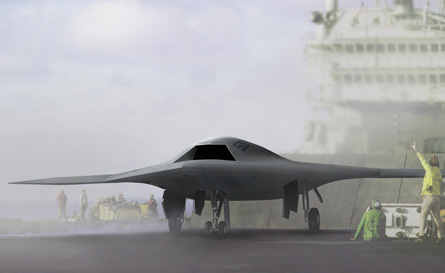The US Navy confirms the scope of the Northrop Grumman X-47 unmanned combat air system demonstration (UCAS-D) has grown to add an autonomous aerial refuelling component.
While the refuelling demonstration is only an addition to the carrier suitability demonstration, its sudden approval marks a sea change in the UCAS-D programme's outlook. Only six months ago, a key defence think-tank in Washington DC called a press conference to warn reporters about internal USN plans to terminate the UCAS-D programme as a cost-saving measure.
"We're obviously very pleased that the navy has decided not only to pursue UCAS-D, but to expand it for all the reasons that we outlined in our report," says Tom Ehrhart, a senior fellow at the Center for Strategic and Budgetary Assessments.
That report - published in June by Ehrhart and Bob Work, the centre's vice-president for strategic studies - holds up the UCAS concept as a key technology to ensure the viability of the carrier strike group for the next few decades. Work is now a member of president-elect Barack Obama's national security transition team, and is a widely rumoured candidate for a top job in the Department of the Navy.
The USN launched UCAS-D in August 2007, awarding a $600 million, five-year development contract to Northrop to build two X-47s. The project is limited to a demonstration to prove the viability of operating a large unmanned aircraft on carrier decks.
 |
|---|
© Northrop Grumman |
But the navy's plan for a follow-on project has evolved since last year. The original plan called for UCAS-D to be followed by a contract to build an operational system in fiscal year 2014. Last May, the USN unveiled plans to acquire a carrier-based fighter-bomber called F/A-XX after 2020, and named the UCAS-D aircraft as a candidate, along with considering manned aircraft for the same role.
Capt Martin Deppe, the navy's UCAS programme manager, has identified the autonomous aerial refuelling (AAR) capability as a critical enabler for the UCAS to compete for any follow-on contract.
"The navy has not yet decided to procure an operational UCAS system beyond the demonstration," he says. "But, from a theoretical perspective, incorporating AAR capability into a carrier-based UAS unleashes an ability to exploit the range and persistence potential of an unmanned system by allowing it to remain airborne much longer than the limits of human endurance."
With carrier strike groups increasing facing anti-access threats, such as medium-range ballistic missiles, the X-47 could be a technological counter. "A refuellable UAS launching from the carrier flight deck could significantly increase the stand-off of the [strike group] from potential anti-access threats," says Deppe.
Source: Flight International























